NUHABITAT’S ASKING-PRICE HISTORIES ARE BACK IN ACTION ![]() Home listing sleuths who’d been relying on historical asking-price data from NuHabitat (when most other consumer-facing MLS sources keep that info hidden) will be relieved to hear that the feature has been restored. Company founder Jeff Burke tells Swamplot the disappearance of the data from NuHabitat’s Price Tracker, which users began noticing last week, was inadvertent; an update pushed out earlier today brings it back. For logged-in users (only), NuHabitat’s Price Tracker provides histories of sales prices as well as details of former asking prices for properties currently on the market, in most cases even if they’ve been yanked over to a new MLS number. (Click on the dollar-sign logo underneath a property listing to see it; the screenshot above shows data for this Cambridge Green property featured on Swamplot last week.) A better dashboard for tagging and setting up alerts on multiple properties should be available to consumer users within a week or so, says Burke, following improvements in the “swipeability” of property images on mobile devices, which went live last month. [NuHabitat; previously on Swamplot]
Home listing sleuths who’d been relying on historical asking-price data from NuHabitat (when most other consumer-facing MLS sources keep that info hidden) will be relieved to hear that the feature has been restored. Company founder Jeff Burke tells Swamplot the disappearance of the data from NuHabitat’s Price Tracker, which users began noticing last week, was inadvertent; an update pushed out earlier today brings it back. For logged-in users (only), NuHabitat’s Price Tracker provides histories of sales prices as well as details of former asking prices for properties currently on the market, in most cases even if they’ve been yanked over to a new MLS number. (Click on the dollar-sign logo underneath a property listing to see it; the screenshot above shows data for this Cambridge Green property featured on Swamplot last week.) A better dashboard for tagging and setting up alerts on multiple properties should be available to consumer users within a week or so, says Burke, following improvements in the “swipeability” of property images on mobile devices, which went live last month. [NuHabitat; previously on Swamplot]
Tag: Houston Data
HOUSTON’S HOTEL BUILDING BOOM  If you’ve been adding up the new Embassy Suites planned for Hughes Landing in The Woodlands, the 14-story combo Hampton Inn and Homewood Suites now beginning construction on Crawford St. between Capitol and Rusk downtown (illustrated at right, directly behind the Marriott Marquis going up one block to the south), and other recent reports of new hotels coming to town, keep counting: Arch-Con’s Michael Vaughn tells Real Estate Bisnow’s Catie Dixon that 66 new hotels will be built in the greater Houston area over the next 2 years, and “that’s mostly just the major brands” that he knows about. [Houston Business Journal; Real Estate Bisnow] Photo: American Liberty Hospitality
If you’ve been adding up the new Embassy Suites planned for Hughes Landing in The Woodlands, the 14-story combo Hampton Inn and Homewood Suites now beginning construction on Crawford St. between Capitol and Rusk downtown (illustrated at right, directly behind the Marriott Marquis going up one block to the south), and other recent reports of new hotels coming to town, keep counting: Arch-Con’s Michael Vaughn tells Real Estate Bisnow’s Catie Dixon that 66 new hotels will be built in the greater Houston area over the next 2 years, and “that’s mostly just the major brands” that he knows about. [Houston Business Journal; Real Estate Bisnow] Photo: American Liberty Hospitality
The Chronicle’s Erin Mulvaney has thrown data from Apartment Data Services into this interactive Google map — to give you a zoomable picture of where all the new apartments are heading in Houston. The green pins show the 19,923 units (in 72 projects) that have opened recently; the red dots show the 23,781 (in 85 complexes) that are currently under construction; and the yellow dots indicate the additional 18,065 apartments (in 61 new developments) that are proposed — or at least the ones the data company is aware of.
- Multifamily construction projects spread over Houston region [Prime Property]
Map: Erin Mulvaney/Houston Chronicle
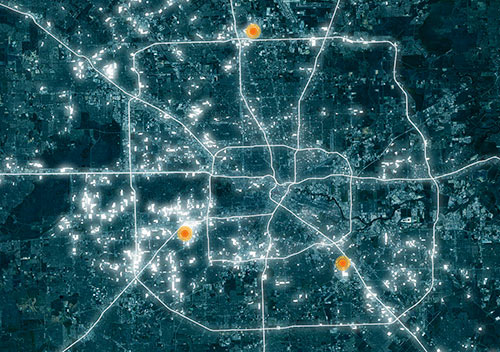
Before delving into the communities residents have built for themselves at the St. Cloud apartment complex on Hillcroft in Gulfton, Thai Xuan Village on Broadway near Hobby Airport, and Greenspoint (each marked in orange on the map), UH architecture prof Susan Rogers tries to present the big picture of Houston’s multifamily situation — accompanied by the above heat map showing (according to HCAD land-use data) where the apartments are: “315,357 is the number of multifamily apartments housed in buildings comprised of 10 or more units. Forty percent of this housing, or just over 140,000 units, were constructed between 1960 and 1979. Today, this housing is home to more than 20 percent of Houston’s two million residents. The units are dispersed in roughly 600 separate complexes, with an average of 250 units, and typically constructed at densities of 30-40 units per acre. Not surprisingly, the new projects are located predominantly outside the Loop and many are in a downward spiral of disinvestment.”
Map: Rose Lee
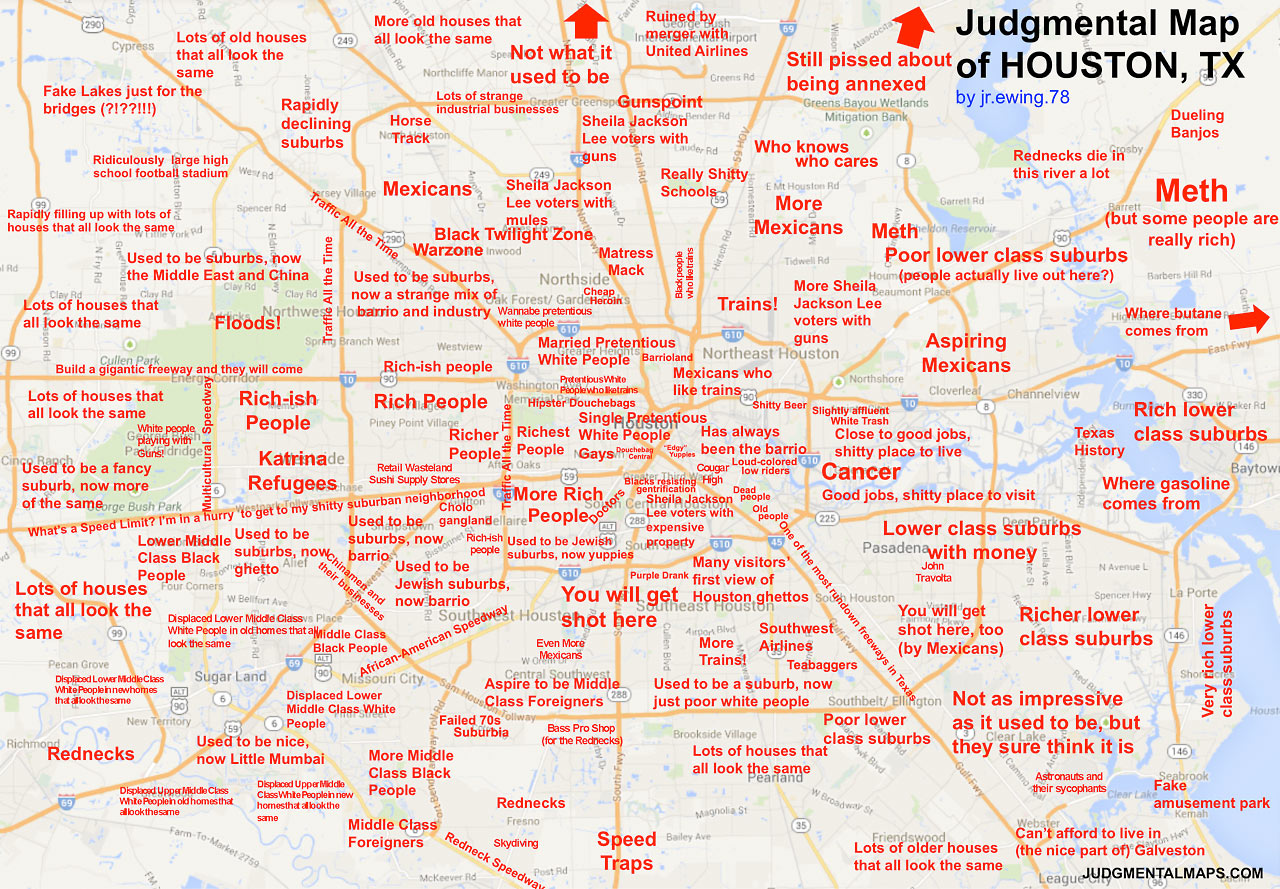
Comedian Trent Gillaspie began his internet cartographic ventures by assembling an annotated map of his then-hometown of Denver, which he posted online hoping to highlight the humor in some of his gentrification-comedy routines with what he hoped would be considered outrageous labels for every neighborhood. “Some are judgmental, some are humorous, and all of them have a little bit of truth,” he explained to Business Insider earlier this year. “As long as you offend everyone you possibly can, it ends up making it OK.” Gillaspie then tried to open up his method to other cities — asking other comedians (and would-be comedians) to put together similar surveys of their own cities. A total of 47 labeled maps of various cities currently comprise the Judgmental Maps website, with varying levels of humor and “light racism,” as Business Insider’s Karyne Levy politely puts it.
The latest effort, submitted to Gillaspie’s website and tagged by its author, identified only as jr.ewing.78, targets Houston. We’ve sliced the map into thirds, for easier reading, below:
A DIRE WARNING FOR HOUSTON, 1965: IN CASE OF NUCLEAR ATTACK, PROPERTY VALUES MAY RISE 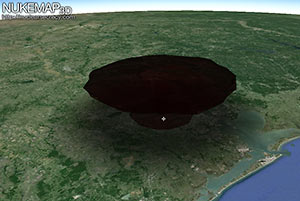 Nuclear historian Alex Wellerstein, creator of the online Nukemap nuclear-blast simulator, finds the following charming nugget in a September 1965 report issued by the nonprofit Institute for Defense Analyses, which wad been hired by the U.S. Army’s Office of Civil Defense to calculate the effects of the use of a nuclear weapon on an American city — using Houston as an example: “For single surface bursts of 3- and 10-Mt, about 64 percent and 46 percent of the property values survive, while only 32 and 18 percent of the unsheltered population survives. In a macabre sense, the surviving population would be individually ‘wealthier’ than before the attack. For a single 10-Mt weapon, surviving property value per capita nearly doubles from a preattack value of about $9,000 to slightly more than $16,000 and, as the weight of the attack increases, the greater the per capita gain in ‘wealth’ of the survivors. For a 100-Mt surface burst, the surviving population is nearly four times wealthier than pre-attack ($34,000). However, any joy among the surviving population may be quite shortlived; none of these gross estimates of the effects of nuclear attack indicate whether or not the immediate metropolitan area is viable, either by itself or with the assistance of the rest of the country.” [Lawyers, Guns, and Money; report (PDF)] Simulated image of 10-megaton mushroom cloud over Houston: Nukemap 3D
Nuclear historian Alex Wellerstein, creator of the online Nukemap nuclear-blast simulator, finds the following charming nugget in a September 1965 report issued by the nonprofit Institute for Defense Analyses, which wad been hired by the U.S. Army’s Office of Civil Defense to calculate the effects of the use of a nuclear weapon on an American city — using Houston as an example: “For single surface bursts of 3- and 10-Mt, about 64 percent and 46 percent of the property values survive, while only 32 and 18 percent of the unsheltered population survives. In a macabre sense, the surviving population would be individually ‘wealthier’ than before the attack. For a single 10-Mt weapon, surviving property value per capita nearly doubles from a preattack value of about $9,000 to slightly more than $16,000 and, as the weight of the attack increases, the greater the per capita gain in ‘wealth’ of the survivors. For a 100-Mt surface burst, the surviving population is nearly four times wealthier than pre-attack ($34,000). However, any joy among the surviving population may be quite shortlived; none of these gross estimates of the effects of nuclear attack indicate whether or not the immediate metropolitan area is viable, either by itself or with the assistance of the rest of the country.” [Lawyers, Guns, and Money; report (PDF)] Simulated image of 10-megaton mushroom cloud over Houston: Nukemap 3D
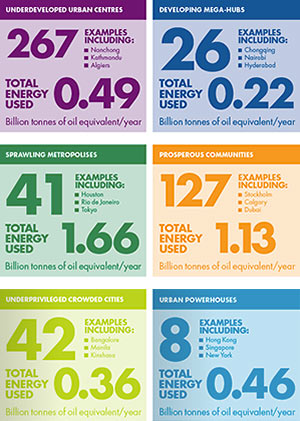 The folks at Shell may not have known a new campaign was about to kick off declaring Houston to be “The City of No Limits,” but a new report from the oil company on the future of cities around the world certainly helps reinforce a just-as-proud image of our 8,778-square-mile Texas spread. “New Lenses on Future Cities,” one of a series of just-released “scenario” studies sponsored by Shell in conjunction with The Centre for Liveable Cities in Singapore, classifies urban areas around the world into 6 distinct categories based on common features.
The folks at Shell may not have known a new campaign was about to kick off declaring Houston to be “The City of No Limits,” but a new report from the oil company on the future of cities around the world certainly helps reinforce a just-as-proud image of our 8,778-square-mile Texas spread. “New Lenses on Future Cities,” one of a series of just-released “scenario” studies sponsored by Shell in conjunction with The Centre for Liveable Cities in Singapore, classifies urban areas around the world into 6 distinct categories based on common features.
Houston, according to the researchers, is too large to be considered one of the Prosperous Communities, and hasn’t earned its way into the Developing Mega-Hubs or Urban Powerhouses clubs. (It certainly doesn’t qualify as an Underprivileged Crowded City or Underdeveloped Urban Centre either) Instead, the report says Houston is a seminal example of a Sprawling Metropolis, proudly featuring it on some accompanying infographics illustrating the archetype (see the green square above). (Other members of this distinctive group of 41 cities include Rio de Janeiro, Tokyo, and Los Angeles.)
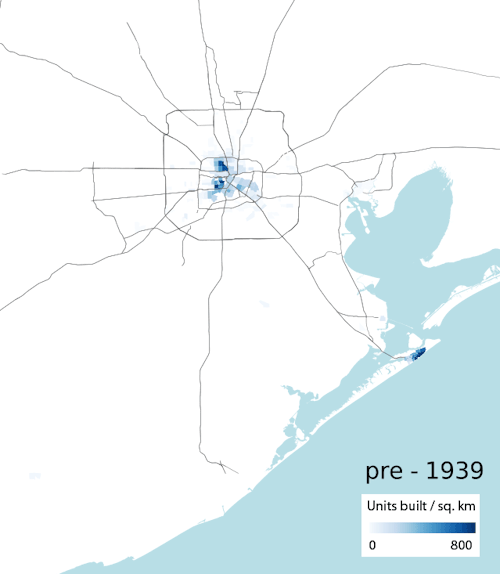
If the Greater Houston Partnership is eager to include some exhibits or animated GIFs to go along with the video footage of cars driving through imaginary barriers, shiny skyscrapers, and smiling people that pepper its new campaign celebrating Houston as The City of No Limits, it might want to look at the work of California computational biologist [and former Houstonian and longtime Swamplot reader] Ian Rees. Using data from the American Community Survey, Rees mapped structures in the region by the decade they were built, grading their concentration with varying shades of blue.  The result helps us visualize the decades-long march of Houston housing ever outward. His map, shown above, was featured in a series of articles on the Next City website on urban sprawl, a few of which compare Houston’s growth to those of other major U.S. cities.
Unfortunately, the data (and the dancing blue construction hotspots) stop in 2010, and we’re left to ourselves to wonder whether Houston is still on track to continue its now-officially-enshrined core mission. An earlier version of Rees’s map breaks out the last recent decade into 2 separate frames, helping to illustrate the scale and sequence of the more recent Inner Loop construction revival:
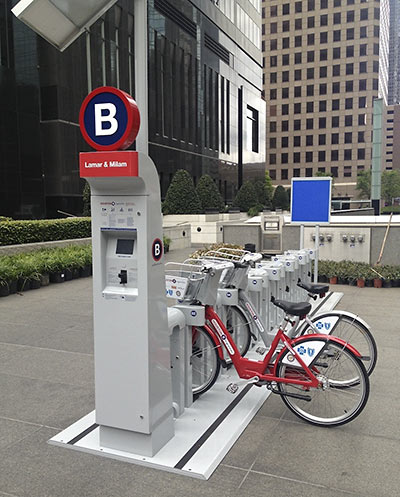
As many as 8 new bike-sharing stations could open inside the Loop in the next 2 weeks. Will Rub, director of Houston B-Cycle, tells Swamplot that permits are in hand and the bikes forthcoming for these 5 stations: Spotts Park, at 401 S. Heights Blvd; the intersection of Taft and Fairview, at 2401 Taft St.; the Menil Collection, at 1529 W. Alabama St.; Leonel Castillo Community Center, which is undergoing a restoration at 2109 South St.; and the intersection of Milam and Webster, at 2215 Milam St.
And Rub adds that 3 other locations are just waiting for their permits: Stude Park, at 1031 Stude St., and 2 others east, for the first time, of the Southwest Fwy.: Settegast Park at Garrow and Palmer in the Second Ward, and Project Row Houses at Holman and Live Oak in the Third Ward. Rub expects those to be ready to roll September 19th or 20th.
- New Locations Coming Soon [Houston B-Cycle]
- B-Cycle spreading west and north of downtown [The Highwayman]
- Previously on Swamplot: Are Houston’s B-Cycles ‘Merely Toys for Urban Bohemians’?, Going Back to the Near Northside School on the Hill, Multiplying Houston’s Rent-a-Bike Fleet, What Bike Sharing in Houston Might Look Like
Photo of station at Lamar and Milam: Reddit user txsupernova
STUDYING HOUSTON’S ROADSIDE AIR QUALITY 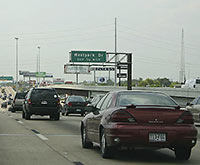 Another source of Houston’s pollution has got the attention of the Texas Commission on Environmental Quality: tailpipes. Starting in January, the agency will place a pair of monitors within 160 ft. of 2 our most heavily used roads — including the Southwest Fwy. near the Westpark Tollway — to record the amount of nitrogen dioxide leaked into the air. Apparently, the stuff can be pretty nasty, writes the Houston Chronicle’s Matthew Tresaugue: “The Environmental Protection Agency said studies have measured concentrations of the gas to be as much as 100 times greater near major roadways than away from them. Scientists, meanwhile, have linked the pollutant to asthma and other lung ailments, especially among children and the elderly.” The results of these monitors, adds Tresaugue, might lead the city to make decisions about preventing schools and residences from being built in and around affected areas. [Houston Chronicle ($); previously on Swamplot] Photo: AA Roads
Another source of Houston’s pollution has got the attention of the Texas Commission on Environmental Quality: tailpipes. Starting in January, the agency will place a pair of monitors within 160 ft. of 2 our most heavily used roads — including the Southwest Fwy. near the Westpark Tollway — to record the amount of nitrogen dioxide leaked into the air. Apparently, the stuff can be pretty nasty, writes the Houston Chronicle’s Matthew Tresaugue: “The Environmental Protection Agency said studies have measured concentrations of the gas to be as much as 100 times greater near major roadways than away from them. Scientists, meanwhile, have linked the pollutant to asthma and other lung ailments, especially among children and the elderly.” The results of these monitors, adds Tresaugue, might lead the city to make decisions about preventing schools and residences from being built in and around affected areas. [Houston Chronicle ($); previously on Swamplot] Photo: AA Roads
Here’s a map from the nonprofit Adopt-a-Pet (sponsored in part by Purina and Bayer, the manufacturer of the Advantage pet meds) you can use to locate the nearest dog shelter in Houston.
After the jump: The cat map.
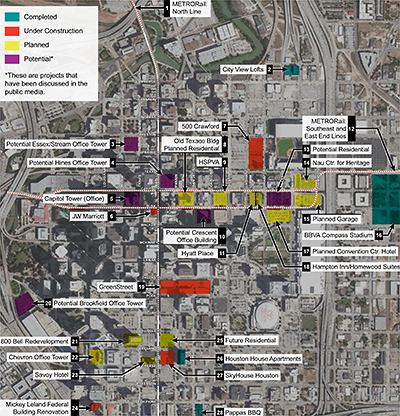
Last week’s announcement by Chevron of the 50-story tower it plans to add to its blue-glass twins is just the latest development in the 77002. This map from the Downtown Management District shows projects that are recently completed, under construction, or in various states of planning and speculation. Those projects, denoted by purple and yellow on the map, include Skanska’s 34-story office tower that’s replacing the old Houston Club Building, Hines’s highrise on Main, the residential renovation of the Texaco Building, and the 5-story apartment complex near the under-construction SkyHouse apartment tower, among others. You can scroll through a complete legend for the map after the jump:
GAINING IN HOUSTON’S GAYBORHOODS 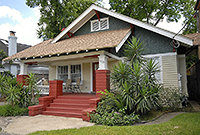 So home prices are rising in urban areas — no surprise there. But nowhere are those prices rising faster than in so-called “gayborhoods.” That’s according to Jed Kolko, crunching the numbers for Trulia: “Neighborhoods where same-sex male couples account for more than 1% of all households (that’s three times the national average) had price increases, on average, of 13.8%. In neighborhoods where same-sex female couples account for more than 1% of all households, prices increased by 16.5% –– more than one-and-a-half times the national increase.” Prime Property’s Nancy Sarnoff adds that in Houston in Rosedale prices are up 16 percent and 14 percent in Hyde Park, where the 1920s Jackson Blvd. bungalow shown here is for sale for $425,000. [Trulia Trends; Prime Property] Photo of 1223 Jackson: HAR
So home prices are rising in urban areas — no surprise there. But nowhere are those prices rising faster than in so-called “gayborhoods.” That’s according to Jed Kolko, crunching the numbers for Trulia: “Neighborhoods where same-sex male couples account for more than 1% of all households (that’s three times the national average) had price increases, on average, of 13.8%. In neighborhoods where same-sex female couples account for more than 1% of all households, prices increased by 16.5% –– more than one-and-a-half times the national increase.” Prime Property’s Nancy Sarnoff adds that in Houston in Rosedale prices are up 16 percent and 14 percent in Hyde Park, where the 1920s Jackson Blvd. bungalow shown here is for sale for $425,000. [Trulia Trends; Prime Property] Photo of 1223 Jackson: HAR

Putting Google’s Landsat Annual Time Lapse function to work, Texas architect Samuel Aston Williams has created animated .GIFs that give a satellite’s view of how certain cities — Shanghai, Atlanta, Lagos, etc. — have changed during the past 30 years. And here’s Houston.
- The Devastating Impact of 30 Years of Sprawl, As Seen From Space [Atlantic Cities]
Image: Samuel Aston Williams via Atlantic Cities
A ‘FIELD GUIDE’ TO HOUSTON FOOD TRUCKS  A new book declares which among the estimated 1,400 are the best food trucks in Houston: Houston Chronicle food writer and UH marketing professor Paul Galvani tells a 392-page story of what he calls “the food truck movement,” providing maps and reviews of his 100 favorites, like Good Dog Hot Dog and The Modular, which gave rise to the recently opened Downtown ramen shop Goro & Gun. Houstonia food writer and El Real Tex Mex co-founder Robb Walsh doesn’t seem to think this is a book meant for the coffee table, blurbing, “I plan to carry a copy in my car as a field guide . . . .” [Houston’s Top 100 Food Trucks; previously on Swamplot] Photo: Houston’s Top 100 Food Trucks via Swamplot inbox
A new book declares which among the estimated 1,400 are the best food trucks in Houston: Houston Chronicle food writer and UH marketing professor Paul Galvani tells a 392-page story of what he calls “the food truck movement,” providing maps and reviews of his 100 favorites, like Good Dog Hot Dog and The Modular, which gave rise to the recently opened Downtown ramen shop Goro & Gun. Houstonia food writer and El Real Tex Mex co-founder Robb Walsh doesn’t seem to think this is a book meant for the coffee table, blurbing, “I plan to carry a copy in my car as a field guide . . . .” [Houston’s Top 100 Food Trucks; previously on Swamplot] Photo: Houston’s Top 100 Food Trucks via Swamplot inbox

